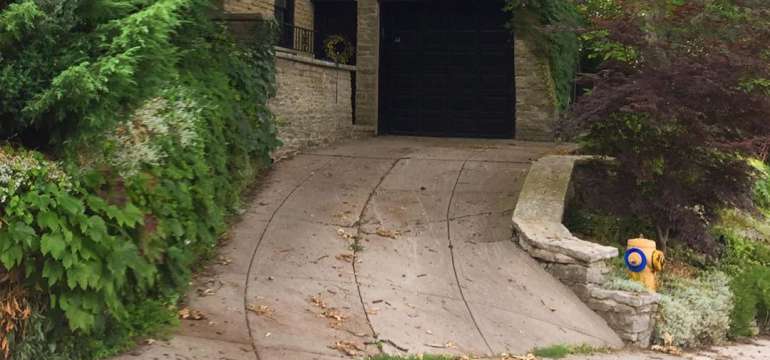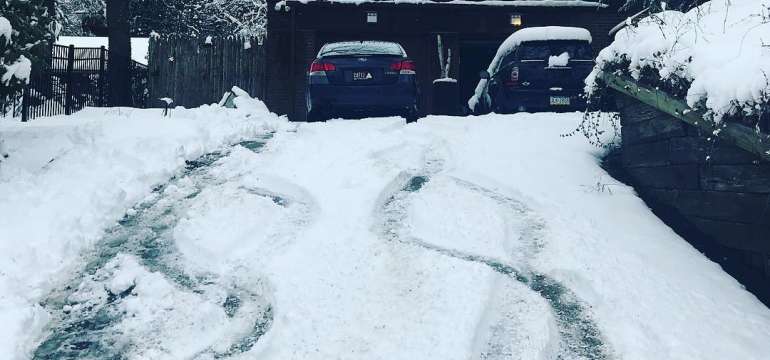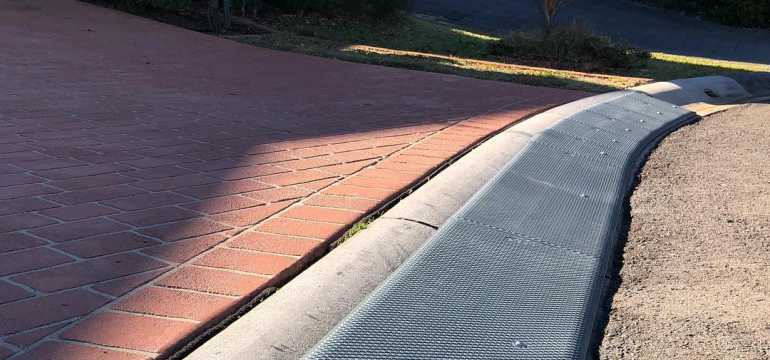Are you stuck in a house with a really steep driveway? Maybe you love the location, the views, the house itself—but the driveway is so steep that it’s a daily hassle and possibly even a cause for safety concerns. Steep driveways make it difficult to back out, and they can also become extremely slippery on rainy days or during the winter.
There are several ways to remedy this issue or to minimize any related safety risks or possible damage to vehicles. Check out our five steep driveway solutions for your home or place of business.
How steep can a driveway be?
If you’re working with new construction and putting in the driveway for the first time, you need to ensure that you’re well-versed in your local building codes and restrictions. It’s likely that your city or county has some regulations for how steep a driveway can be.
Ideally, the angle of the slope shouldn’t be any steeper than 12% or 15% in most cases. However, in some situations, such as hilly neighborhoods or mountainside locations, a sharper angle may be permitted.
The maximum grade allowed for driveways is usually a 25-foot rise over a length of 100 feet or a 25% rise. But for a driveway that sharply angled, you’ll need a transition zone at the base, a more gradual slope to ease the driveway into a pedestrian or traffic area.
The transition zone is important for the protection of people using the sidewalk and for the safety of other cars going by in the street. It’s also ideal for your vehicle since a sharp bump at the end of the driveway can take a toll on your car’s body and undercarriage.
1. Apply gravel to your steep driveway

If you have a steep incline from your recently constructed home, consider putting in a gravel driveway instead of a paved one. Applying gravel to your steep driveway can provide extra traction.
However, keep in mind that the gravel will gradually erode or roll to the foot of the slope, so you’ll have to add more gravel periodically. This solution works best if your main concern is slippery conditions, rather than visibility or vehicle damage.
2. Add curves to your steep driveway

You could always dig up the existing driveway and redesign it completely. This is, admittedly, a pricey option. However, if the slope between the house and the street is very dramatic, you may need to consider adding a curve to the driveway to make the descent more gradual and manageable.
Don’t try doing this job on your own; you’ll need experienced professionals to help you plan the right kind of curve for the driveway. The grading and edging of the driveway have to be done correctly, or you’ll run the risk of the car sliding right off the prescribed path and skidding down the unpaved slope.
3. Create a safety barrier

Speaking of cars skidding off the driveway—consider adding protective barriers on either side of the vehicle’s path. If your car begins to slip due to rain or ice, ridges or barriers along the edges of the paved surface can stop your slide and redirect your vehicle. Decorative stones, low brick walls, a short fence, hedges, and similar elements serve this function well.
4. Add a steep driveway ramp

In some cases, the incline of the driveway may be due to gradual erosion over time. If there’s a dip, hollow, or sunken area at the base of the driveway, you can fill in that spot with compacted gravel and sand. On top of that compressed fill, add concrete to create a new ramp at the foot of the driveway. The fill area should be carefully graded to reduce the overall slope of the drive.
For a smaller dip or hollow at the end of the driveway, you may be able to purchase a temporary steel ramp to bridge the gap and offer a more gradual exit. Be sure to get a ramp with a tread plate for maximum traction.
5. Consider a resin driveway surface

Concrete, pavement, and gravel can only provide limited traction and stability. For some dramatically sloped driveways, the resin is the ideal choice. If your driveway area has drainage issues, install pipes first to direct water away and prevent erosion.
Then fill in the area with compressed sand and gravel and add a layer of decomposed granite over that. Finally, apply the stabilizing resin as the top layer. You’ll find a resin surface to be far safer in rainy or icy conditions.
Reworking or repaving a driveway is a massive undertaking. It’s vital that you consult with an expert to ensure that any drainage issues or potential erosion problems are taken care of so you won’t have to spend more money to fix damage resulting from a poorly planned driveway design.
With a professional eye on the project and some DIY labor to save money, you can revamp an existing steep driveway and make it easier and safer to navigate.
- How to Get Rid of Wood Mites - September 24, 2020
- Can You Have Stained Doors With Painted Trim? - May 27, 2020
- Is Duct Tape Flammable? and Other Burning Questions About Duct Tape - April 2, 2020


Chris
Sunday 8th of August 2021
In the past....I've seen people just park at the bottom of the drive/street and just hike to the house or use a side-by-side ATV. :)
M price
Tuesday 18th of August 2020
I’m buying a house with a very steep driveway. Everything about the house is perfect but the driveway the slope is dangerous in the winter time with ice and snow. How can I make it safe?